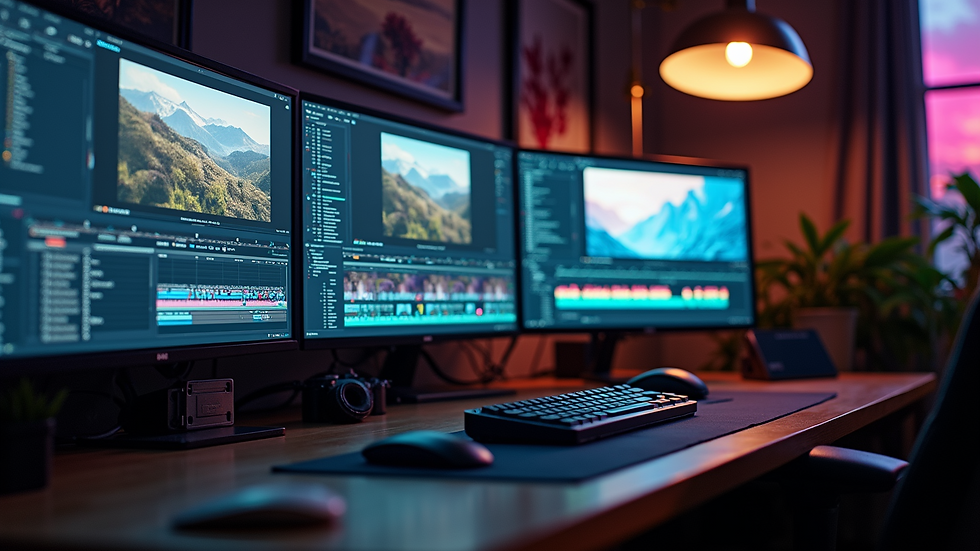Understanding the Role of GPUs in Modern Computing
- Ram Gobinda
- Jun 30
- 4 min read
In the ever-evolving landscape of technology, the role of Graphics Processing Units (GPUs) has become paramount. Modern GPUs have transcended their initial purpose of rendering graphics for video games and are now crucial for various computational tasks. This post aims to shed light on the significance of modern GPUs and their broad applications across different sectors.
What are Modern GPUs?
Modern GPUs are designed to handle complex calculations simultaneously, making them ideal for tasks that require heavy parallel processing. Unlike Central Processing Units (CPUs), which are optimized for single-threaded tasks, GPUs excel at performing multiple operations at once.
The architecture of a GPU allows it to process thousands of threads concurrently. This makes GPUs particularly valuable in fields such as machine learning, scientific simulations, and data analysis. The increase in available core counts has driven advancements in rendering high-quality graphics and executing complex computational tasks.

Applications of Modern GPUs
The versatility of modern GPUs has enabled them to be pivotal in various fields. Below are some areas where GPUs have made significant contributions:
1. Gaming
The gaming industry is one of the most visible sectors benefiting from GPU advancements. Modern graphics cards deliver stunning visual fidelity and immersive experiences. Technologies such as ray tracing utilize powerful GPUs to simulate realistic lighting and shadows, significantly enhancing game graphics.
2. Artificial Intelligence
In the realm of artificial intelligence (AI), GPUs facilitate faster training of neural networks. Tasks like image and speech recognition require heavy data processing, and modern GPUs enable these processes to be completed in a fraction of the time it would take using traditional processors. Research indicates that training a deep learning model can take weeks on a CPU but can be reduced to days or even hours when using a GPU.
3. Video Editing and Animation
For professionals in video editing and animation, GPUs play an essential role in rendering high-resolution videos in real-time. Software like Adobe Premiere Pro and Final Cut Pro leverage GPU acceleration to enhance performance, allowing creators to work on complex projects without significant delays.
Image Placeholder

4. Cryptocurrency Mining
The rise of cryptocurrencies has also fueled demand for powerful GPUs. Cryptocurrency mining involves solving complex mathematical problems to validate transactions, which requires substantial computational power. Miners often use multiple GPUs to maximize efficiency and profitability.
5. Scientific Research
Modern GPUs are increasingly being used in scientific research for simulations and data analysis. Fields such as genomics, climate modeling, and quantum physics benefit from the parallel computing capabilities of GPUs. For example, researchers can simulate molecular interactions or model weather patterns much faster than with CPUs alone.
Why 2 Graphics Cards?
Many users wonder why they would need two graphics cards in their system. The primary advantage is enhanced performance, particularly in demanding applications like gaming, video editing, or 3D rendering. By utilizing two GPUs, users can achieve higher frame rates and better graphics quality.
Another reason is redundancy. In professional environments, having a backup graphics card ensures that any single GPU failure does not halt productivity. However, it’s important to note that not all software can utilize multiple GPUs efficiently, so it is crucial to check compatibility before investing.

The Future of GPUs
The future of modern GPUs looks promising, with continuous advancements in technology. Upcoming trends include improvements in ray tracing capabilities and increased energy efficiency. With the advent of AI and machine learning, we anticipate GPUs will become even more intelligent, optimizing tasks dynamically as they learn from user patterns.
Furthermore, the introduction of new architectures like NVIDIA's Ampere and AMD’s RDNA 2 has set the stage for significant upgrades in computational power and performance. As we venture deeper into augmented and virtual realities, the demand for even more powerful GPUs will become more pronounced.
Maximizing GPU Performance
To ensure that you are getting the most out of your modern GPU, consider the following recommendations:
Keep Drivers Updated: Regular updates to GPU drivers can lead to performance enhancements and stability improvements. Always check for the latest version from your manufacturer.
Monitor Temperature: High temperatures can affect GPU performance and longevity. Use monitoring software to keep track of the temperature and ensure proper cooling solutions are in place.
Optimize Game Settings: Many games allow you to adjust graphics settings to strike a balance between performance and visual fidelity. Experiment with settings to find what works best for your setup.
Utilize GPU Acceleration in Software: Many applications, especially in video editing and AI, provide options for GPU acceleration. Make sure to enable these settings to optimize workload distribution.
Upgrade Regularly: Technology evolves rapidly; therefore, consider upgrading your GPU periodically to keep up with the latest applications and trends in modern computing.
As GPUs continue to play a significant role in modern computing, staying informed about the advancements and capabilities of these powerful components will be crucial for both professionals and enthusiasts alike. Embracing this technology will enable users to harness its capabilities for innovative solutions and enhanced productivity across various domains.






GPUs have definitely gone far beyond just gaming visuals — and funny enough, when I’m not tweaking performance settings, I’ve been exploring apps like zuplay apk It’s a casino and betting platform optimized for mobile, with smooth performance, secure logins, and a wide variety of games that run seamlessly, kind of like how GPUs optimize workloads across fields today.
hi